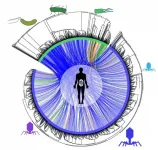(Press-News.org) Global targets to improve the welfare of people across the planet will have mixed impacts on the world's forests, according to new research.
The United Nations' 17 key areas for global development - known as the Sustainable Development Goals (SDGs) - range from tackling poverty, hunger and sanitation to promoting clean energy, economic growth and reducing inequality.
Many of these goals, such as improved peace and justice, good health and wellbeing, and quality education, will have a positive impact on the Earth's natural forests.
But others, including creating new roads, industry and infrastructure, are likely to have detrimental consequences.
The research, led by the University of Leeds, reviewed a wide range of existing academic papers into the UN's global goals.
The findings, funded by the Natural Environment Research Council and the United Bank of Carbon, are published in the journal Forest Policy and Economics.
Lead author Jamie Carr, of Leeds' School of Earth and Environment, said: "Almost none of the 17 goals are universally good or bad for forests.
"The only exception to this is the goal concerning education, for which all impacts were identified as beneficial. Well-being and social progress are also most commonly associated with beneficial outcomes.
"Overall, targets relating to energy and infrastructure have the potential to be the most damaging to the world's forest ecosystems.
"For example, negative impacts were associated with hard infrastructure including roads, railways, dams, housing and industrial areas.
"In particular, there is good evidence to suggest that roads designed to boost access to markets are especially damaging for forests.
"Other damaging impacts included efforts to combat cocaine-associated crime in Colombia. Despite having some forest benefits, coca crop eradication has been shown to result in cultivators simply moving their activities elsewhere or switching to even more damaging agricultural practices.
"Overall, beneficial impacts are more numerous than damaging ones, but are typically less well understood. This suggests an urgent need for increased research on these so that society and policymakers can take full advantage."
Forest ecosystems also help to mitigate against climate change while offering watershed protection and preventing soil erosion. In addition, about 1.6 billion people live near forests, and hundreds of millions depend on forest products in the form of fuel, food and timber.
The UN goals to create a fairer society for everyone are broken down into 169 more specific targets. These were agreed by the organisation's General Assembly in 2015 and are intended to be achieved by 2030.
The research team led by the University of Leeds included scientists from the University of Oxford, the International Union for Conservation of Nature, the United Nations Environment Programme World Conservation Monitoring Centre, and the International Institute for Environment and Development.
They reviewed 466 academic papers on the UN targets, collecting 963 examples of impacts.
They found that 63 of the 169 targets were likely to have effects on forests that were either damaging or beneficial, or in some cases, both.
Of the identified impacts, 29 were potentially beneficial, 15 damaging and 19 had mixed impacts.
Identifying and understanding these effects will help Governments to avoid negative impacts, while capitalising on the positive ones.
Lead supervisors of the research were Professor Dominick Spracklen and Dr Susannah Sallu, of Leeds' School of Earth and Environment.
Dr Sallu said: "Institutions working to help achieve the UN goals need to be aware that their actions can have negative implications for forests and the environmental services these forests provide.
"Inter-sectoral coordination between agriculture, energy, health, transport and forest sectors can help ensure future development does not cause unintended consequences.
"Inclusive planning involving a diverse range of society further minimises the potential for negative impacts."
INFORMATION:
Further information
Anticipated impacts of achieving SDG targets on forests - a review is published February 2021 in Forest Policy and Economics. DOI: https://doi.org/10.1016/j.forpol.2021.102423
Author affiliations: University of Leeds; University of Oxford; International Union for Conservation of Nature; UN Environment Programme World Conservation Monitoring Centre; International Institute for Environment and Development.
Funding was provided by the UK's Natural Environment Research Council (NERC) and the United Bank of Carbon (UBoC).
The United Nations' 17 Sustainable Development Goals are: (1) No Poverty, (2) Zero Hunger, (3) Good Health and Well-being, (4) Quality Education, (5) Gender Equality, (6) Clean Water and Sanitation, (7) Affordable and Clean Energy, (8) Decent Work and Economic Growth, (9) Industry, Innovation and Infrastructure, (10) Reduced Inequalities, (11) Sustainable Cities and Communities, (12) Responsible Consumption and Production, (13) Climate Action, (14) Life Below Water, (15) Life On Land, (16) Peace, Justice, and Strong Institutions, (17) Partnerships for the Goals.
For further details, contact Ian Rosser in the University of Leeds press office via i.rosser@leeds.ac.uk
Nearly 100 percent of the red snapper sampled in the Gulf of Mexico over a six-year period by University of South Florida (USF) marine scientists showed evidence of liver damage, according to a study reported in Aquatic Toxicology.
The study is the first to correlate the concentration of crude oil found in the workhorses of the digestive system -- the liver, gall bladder, and bile - with microscopic indicators of disease, such as inflammation, degenerative lesions, and the presence of parasites. The team sampled nearly 570 fish from 72 Gulf locations between 2011 to 2017 in the wake of the historic 2010 Deepwater Horizon oil spill.
"The results add to the list of other species we've analyzed indicating early warning ...
In a breakthrough for quantum computing, University of Chicago researchers have sent entangled qubit states through a communication cable linking one quantum network node to a second node.
The researchers, based in the Pritzker School of Molecular Engineering (PME) at the University of Chicago, also amplified an entangled state via the same cable first by using the cable to entangle two qubits in each of two nodes, then entangling these qubits further with other qubits in the nodes.
The results, published February 24, 2021 in Nature, could help make quantum computing more feasible and could lay the groundwork for future quantum communication networks.
"Developing methods that ...
"Phase transitions" are a central phenomenon in physical sciences. Despite being technical-sounding, they are actually something we all experience in everyday life: ice melting into liquid water, or hot water evaporating as steam. Solid, liquid, and gas are three well known "phases" and, when one turns into another, that is a phase transition.
Rare-earth nickelate oxides, also called nickelates, have attracted a lot of interest from researchers because they display an electronic phase transition, which may be exploited in future electronic devices. This particular phase transition consists of turning from a metallic ...
Game theory is known to be a useful tool in the study of Machine Learning (ML) and Artificial Intelligence (AI) Multi-Agent interactions.
One basic component of these ML and AI systems is the exploration-exploitation trade-off, a fundamental dilemma between taking a risk with new actions in the quest for more information about the environment (exploration) and repeatedly selecting actions that result in the current maximum reward or (exploitation).
However, the outcome of the exploration-exploitation process is often unpredictable in practice and ...
The balance of human intestinal microbiota, consisting of hundreds of bacterial species and phages (bacteria viruses), is crucial to good health. A research team, including scientists from the CNRS* and the Institut Pasteur, has characterised the phage-bacterial interaction networks of the microbiota in ten healthy individuals, with unprecedented precision. Scientists detected several hundred bacterial and phage genomes and identified the thousands of interactions that bind them by quantifying the contacts between the DNA molecules of viruses and their hosts. This method has the advantage ...
Researchers have published a study revealing their successful approach to designing much quieter propellers.
The Australian research team used machine learning to design their propellers, then 3D printed several of the most promising prototypes for experimental acoustic testing at the Commonwealth Scientific and Industrial Research Organisation's specialised 'echo-free' chamber.
Results now published in Aerospace Research Central show the prototypes made around 15dB less noise than commercially available propellers, validating the team's design methodology.
RMIT University aerospace engineer and lead researcher Dr Abdulghani Mohamed said the impressive results were enabled by two key innovations - the numerical algorithms ...
Researchers at the University of Alabama at Birmingham have identified a new molecular target that could potentially treat the deadly, aging-related lung disease idiopathic pulmonary fibrosis (IPF). The study, which will be published March 10 in the Journal of Experimental Medicine (JEM), suggests that targeting a protein called MDM4 could prevent respiratory failure by initiating a genetic program that removes scar tissue from the lungs.
IPF is characterized by the accumulation of scar tissue that stiffens the lungs and makes it difficult for patients to breathe and get sufficient oxygen into their blood. Though the causes of IPF remain unclear, age is a significant risk factor: the disease is ...
Blood pressure measurements in children and adolescents should be taken from both arms after new research showed substantial differences could be seen depending on which arm was used.
The study, led by the Murdoch Children's Research Institute (MCRI) and published in the Journal of Hypertension, found even a small difference in blood pressure measurements between arms could lead to a wrong diagnosis.
MCRI PhD candidate and study lead author Melanie Clarke said this was the first study worldwide to determine the size and frequency of inter-arm blood pressure differences in children and adolescents.
The study involved ...
A researcher at the Instituto de Astrofísica de Canarias (IAC) is the lead author of a study with proposals for "technosignatures" -evidence for the use of technology or industrial activity in other parts of the Universe- for future NASA missions. The article, published in the specialized journal Acta Astronautica, contains the initial conclusions of a meeting of experts in the search for intelligent extraterrestrial life, sponsored by the space agency to gather advice about this topic.
In the article, several ideas are presented to search for technosignatures that would indicate the existence of extraterrestrial civilizations, ...
They say a picture is worth a thousand words. However, many women artists - and the stories their works tell - comprise less than 4 per cent of total art sold at auction and fail to attract high selling prices compared to male artists.
A world-first international study by researchers at Monash University, Maastricht University (The Netherlands) and Artnet Worldwide, based in New York City, found that a staggering 96.1 per cent (2,572,346) of all artworks sold at auctions worldwide between 2000 and 2017 are attributed to male artists.
However, work by female artists are on average 4.4 per cent more ...








